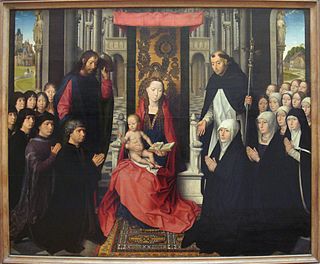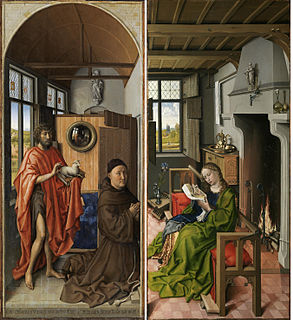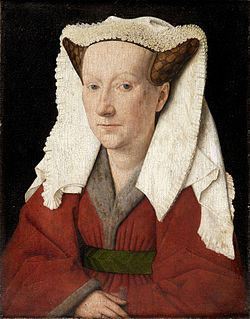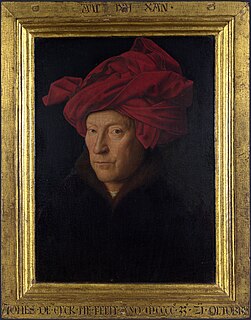Related Research Articles

Jan van Eyck was a painter active in Bruges who was one of the early innovators of what became known as Early Netherlandish painting, and one of the most significant representatives of Early Northern Renaissance art. According to Vasari and other art historians including Ernst Gombrich, he invented oil painting, though most now regard that claim as an oversimplification.

Hans Memling was a painter active in Flanders, who worked in the tradition of Early Netherlandish painting. He was born in the Middle Rhine region and probably spent his childhood in Mainz. He moved to the Netherlands and spent time in the Brussels workshop of Rogier van der Weyden. He was subsequently made a citizen of Bruges in 1465, where he became one of the leading artists, running a large workshop, which painted religious works that often incorporated donor portraits of his wealthy patrons. Memling's patrons included burghers, clergymen, and aristocrats.

Adriaen Isenbrandt or Adriaen Ysenbrandt was a painter in Bruges, in the final years of Early Netherlandish painting, and the first of the Dutch and Flemish Renaissance painting of the Northern Renaissance. Documentary evidence suggests he was a significant and successful artist of his period, even though no specific works by his hand are clearly documented. Art historians have conjectured that he operated a large workshop specializing in religious subjects and devotional paintings, which were executed in a conservative style in the tradition of the Early Netherlandish painting of the previous century. By his time, the new booming economy of Antwerp had made this the centre of painting in the Low Countries, but the previous centre of Bruges retained considerable prestige.

Early Netherlandish painting, traditionally known as the Flemish Primitives, refers to the work of artists active in the Burgundian and Habsburg Netherlands during the 15th- and 16th-century Northern Renaissance period. It flourished especially in the cities of Bruges, Ghent, Mechelen, Leuven, Tournai and Brussels, all in present-day Belgium. The period begins approximately with Robert Campin and Jan van Eyck in the 1420s and lasts at least until the death of Gerard David in 1523, although many scholars extend it to the start of the Dutch Revolt in 1566 or 1568–Max J. Friedländer's acclaimed surveys run through Pieter Bruegel the Elder. Early Netherlandish painting coincides with the Early and High Italian Renaissance, but the early period is seen as an independent artistic evolution, separate from the Renaissance humanism that characterised developments in Italy. Beginning in the 1490s, as increasing numbers of Netherlandish and other Northern painters traveled to Italy, Renaissance ideals and painting styles were incorporated into northern painting. As a result, Early Netherlandish painters are often categorised as belonging to both the Northern Renaissance and the Late or International Gothic.

Advent and Triumph of Christ is an oil painting on a panel of wood, painted c.1480 by German-born Early Netherlandish painter Hans Memling. It was made for the altar of the Tanners' guild in Our Lady's Church in Bruges, but is now held by the Alte Pinakothek in Munich.

Virgin and Child with Four Angels is a small oil-on-panel painting by the Early Netherlandish artist Gerard David. Likely completed between 1510 and 1515, it shows the Virgin Mary holding the child Jesus, while she is crowned Queen of Heaven by two angels above her, accompanied by music provided by another two angels placed at either side of her. In its fine detail and lush use of colour the work is typical of both David and late period Flemish art.

The Werl Triptych is a triptych altarpiece completed in Cologne in 1438, of which the center panel has been lost. The two remaining wings are now in the Prado in Madrid. It was long attributed to the Master of Flémalle, now generally believed to have been Robert Campin, although this identity is not universally accepted. Some art historians believe it may have been painted as a pastiche by either the workshop or a follower of Campin or the Master of Flémalle.

The Portrait of Cardinal Niccolò Albergati is a painting by early Netherlandish painter Jan van Eyck, dating to around 1431 and now in the Kunsthistorisches Museum of Vienna, Austria.

Portrait of Margaret van Eyck is a 1439 oil on wood painting by the Early Netherlandish master Jan van Eyck. It is one of the two latest of his surviving paintings, and one of the earliest European artworks to depict a painter's spouse. Completed when she was around 34, it was hung until the early 18th century in the Bruges chapel of the Guild of painters. The work is thought to be a pendant or diptych panel for either a now lost self-portrait known from records until 1769, or of Jan van Eyck's likely self-portrait now in the National Gallery in London.

The Virgin and Child with Canon van der Paele is a large oil-on-oak panel painting completed around 1434–1436 by the Early Netherlandish painter Jan van Eyck. It shows the painting's donor, Joris van der Paele, within an apparition of saints. The Virgin Mary is enthroned at the centre of the semicircular space, which most likely represents a church interior, with the Christ Child on her lap. St. Donatian stands to her right, Saint George—the donor's name saint—to her left. The panel was commissioned by van der Paele as an altarpiece. He was then a wealthy clergyman from Bruges, but elderly and gravely ill, and intended the work as his memorial.

The Miraculous Draft of Fishes is a 1444 oil on wood panel painting by the Swabian artist Konrad Witz, on view in the Museum of Art and History in Geneva, Switzerland. Witz was the first artist to be recognized for incorporating large landscapes in paintings with large amounts of detail. The landscape has a panoramic view of Lake Geneva and was a significant accomplishment for Northern Renaissance Art.

Saint Barbara is a small 1437 drawing on oak panel, signed and dated 1437 by the Netherlandish artist Jan van Eyck. It is unknown if the work is a chalk ground study in pencil for a planned oil painting, an unfinished underdrawing or a completed work in of itself, although the latter is deemed more likely. The panel shows Saint Barbara imprisoned in a tower by her pagan father, to preserve her from the outside world, especially from suitors he did not approve of. While there, she converted to Christianity, enraging her father and leading to her murder and martyrdom.

Portrait of a Man with a Blue Chaperon is a very small oil on panel portrait of an unidentified man attributed to the Early Netherlandish painter Jan van Eyck.
Vera Icon is a lost oil-on panel portrait by the Early Netherlandish painter Jan van Eyck, which probably formed half of a since dismantled diptych. The original is known through three contemporary copies from his workshop. They were completed in 1438, 1439 and 1440; with the first and last in Bruges, and the 1439 version in Munich.

Portrait of Jan de Leeuw is a small 1436 oil on wood painting by the Early Netherlandish master Jan van Eyck, now in the Kunsthistorisches Museum, Vienna. De Leeuw was a goldsmith living in Bruges; most art historians accept that, given the familiarity of the portrait, that he and van Eyck knew each other and were on good terms. The work is still in its original frame, which is painted over to look like bronze.

Saint Christopher is a lost painting by Jan van Eyck. The painting is mainly recorded through a c 1460–70 copy on oil on oak panel, in the Philadelphia Museum of Art since 1917, and a c 1480 drawing at the Musee du Louvre. The c 1460–70 copy is by an unknown follower. Each show a giant, bearded man, wading through water with a large stick, carrying the infant Christ on his shoulders. The implication is that St. Christopher, patron saint of travelers, carries the weight of the world on his back; The works show him leaning on a large stick as Christ holds a globe, with arms raised in blessing, his robe billowing to the right. The pair are set in a highly detailed, richly coloured and atmospheric landscape. There are jagged rocks on either side, set against an early evening sky, with star formations.

The Annunciation is an oil painting on oak panel attributed to Early Netherlandish painter Hans Memling. It depicts the Annunciation, the archangel Gabriel's announcement to the Virgin Mary that she would conceive and become the mother of Jesus, described in the Gospel of Luke. The painting was completed c. 1482 and was partially transferred to canvas in the 1920s; it is today held in the Robert Lehman collection of the Metropolitan Museum of Art in New York.

Study for Cardinal Niccolò Albergati is a silverpoint drawing attributed to the Early Netherlandish painter Jan van Eyck, made in preparation for his Portrait of Cardinal Niccolò Albergati of 1431. Niccolò Albergati was a diplomat working under Pope Martin V. He met van Eyck during a peace congress in Antwerp, when the artist portrayed him. It is held in the collection of the Staatliche Kunstsammlungen in Dresden.

Portrait of a Man in a Red Hat is an 1465-1470 oil on oak panel painting by Hans Memling, one of the first portraits he produced in Bruges, with similarities to his Portrait of a Man - its subject is unknown. It has some similarities to portraits by Jan van Eyck and Rogier van der Weyden, though the fictive stone frame is Memling's invention.
References
- ↑ H. Verougstraete, Jacqueline Couvert, Roger Schoute, Anne Dubois (eds.): La peinture ancienne et ses procédés: copies, répliques, pastiches. Leuven: Peeters 2006 ISBN 9789042917767, p. 26.
- ↑ "A fake Memling or a genuine Van der Veken? -".
- ↑ "Till-Holger Borchert and Hubert De Witte new directors of Musea Brugge -". 18 December 2014.
- ↑ "till-holger-borchert-au-musée-suermondt-ludwig-". 12 May 2022.
- ↑ "Dorothy Kayser Hohenberg Chairs of Excellence in Art History". The University of Memphis.
- ↑ "Annual Hohenberg Lecture Focuses on Jan van Eyck Archived 2014-09-07 at the Wayback Machine ", memphis.edu, 2008. Retrieved 9 April 2012.
- ↑ "Memling, il maestro fiammingo odiato da Michelangelo".
- ↑ "In Bruges: sea plastic, Chinese crabs and a Spanish pool take centre stage at triennial -". 4 May 2018.
- ↑ "kestrel-burgher-spout. Van Eyck: An optical Revolution -". 6 April 2020.